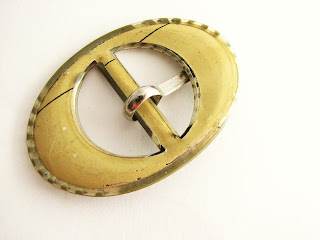In the twentieth century, thanks to the invention of plastic, their production soared. The earliest buckles were made of metal and enamel, with cut steel details and occasional rhinestone. Or pressed brass, with embossed art nouveau style. Mother of pearl buckles were not uncommon too. Not that decorative perhaps, but without plastic people had to be creative.
The second picture is actually a trouser buckle, used to adjust waistbands and waistcoats. They have double prong and a 'fishtail' on the opposite side.
In the roaring twenties many belts were worn not at the waist, but lower, perhaps around the hips, and also on the hats.
The decade of 1930s saw a real boom in button and buckle productions, for two reasons. One was the already mentioned plastic, in form of casein and Bakelite that became more widely available. The other one, a bit unlikely, was the global crisis of the 1929, which affected not only the USA but Europe as well, to much extend. How would that influence the buckle production? Well, impoverished families were looking into ways of improving the monthly budget and many would manufacture them at home. That's why they are so unique and there are so many styles.
Metal pieces, such as hooks or bars were virtually screwed to the Bakelite buckles, but also Casein. One reason for that is that they were made of large sheets of plastic, from which individual pieces were cut out, shaped, decorated and they fitted the closures. The same goes for tongue buckle, which would have metal prongs or a matching plastic one, made of the same sheet.
Layered sheets were common, as were inlays and buckles made of different pieces, like the one I used for the Bakelite test here.
Another type of buckle from this time is celluloid on tin, made of printed celluloid sheets placed on metal base. There were buttons made in a matching style too. These are, however, much less durable than solid celluloid or lucite buckles.
The second photo here is of the back of the buckle. It seems that the metal pieces is recycled from a tin packaging or something. As you can see, all of them feature beautiful art deco designs.
The next decade, 1940s did not bring much novelty. Only that the designs were perhaps more sober, until the WW2 was well over. Metal, so demanded in the war, was replaced by wood for fabric-covered buckles, but the styles remained very decorative. If plastic was used, it was either recycled or a very thin layer was destined for buckle-making.
I also have a vast selection of buckles that pre-date the 1920s, meant for the half-open jackets and coats, whose lapels were joined by ornamental, dainty pieces, often with dangling chains and other pieces. You will see similar buckles a lot in the TV show Downton Abbey.
 |
| Here is just a sample, and they are all still placed on their original cards! Many have filigree details. You will find them in the clasp buckles section |
💢
The decade of 1930s saw a real boom in button and buckle productions, for two reasons. One was the already mentioned plastic, in form of casein and Bakelite that became more widely available. The other one, a bit unlikely, was the global crisis of the 1929, which affected not only the USA but Europe as well, to much extend. How would that influence the buckle production? Well, impoverished families were looking into ways of improving the monthly budget and many would manufacture them at home. That's why they are so unique and there are so many styles.
Metal pieces, such as hooks or bars were virtually screwed to the Bakelite buckles, but also Casein. One reason for that is that they were made of large sheets of plastic, from which individual pieces were cut out, shaped, decorated and they fitted the closures. The same goes for tongue buckle, which would have metal prongs or a matching plastic one, made of the same sheet.
Layered sheets were common, as were inlays and buckles made of different pieces, like the one I used for the Bakelite test here.
Another type of buckle from this time is celluloid on tin, made of printed celluloid sheets placed on metal base. There were buttons made in a matching style too. These are, however, much less durable than solid celluloid or lucite buckles.
 |
| The back side of this buckle must have been recycled from some food packaging |
The second photo here is of the back of the buckle. It seems that the metal pieces is recycled from a tin packaging or something. As you can see, all of them feature beautiful art deco designs.
💢
 |
| A collection of wooden buckle blanks. You will still find some of these styles in my shop! |
💢
1950s brought many new styles in the world of buckles. Women liked to show off their narrow waists again, and lots of times using statement buckles. They were again made of plastic or metal covered in fabric, matching or contrasting.
💢
In the 1960s buckles were sidelined by more modern designs, especially the minimalist lines that the dresses were increasingly made in. However, some buckles were still used, but more geometric: round, rectangular, etc. They were plastic mostly, possibly covered in print and sometimes crazy colours!
Some of the presented here buckles are from later decades, with nylon pieces among them, too. The prongs are increasingly made of materials that can stand machine washing, but some may rust in the process, so it is best not to wash the buckles at all. They may be prone to breaking during spinning or tumble-drying. I usually remove the whole belt before I put the dress in the washing machine just to make sure. If necessary, I resort to hand-washing.













No comments:
Post a Comment